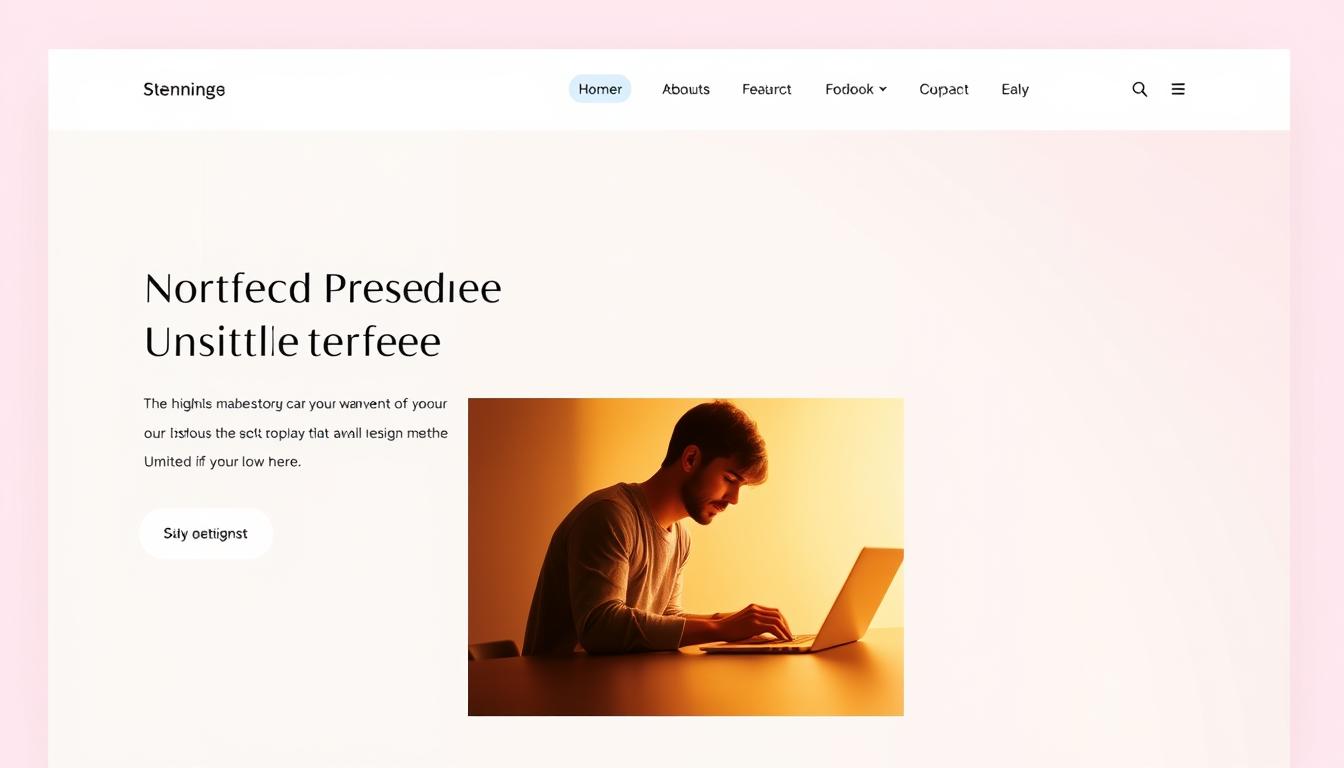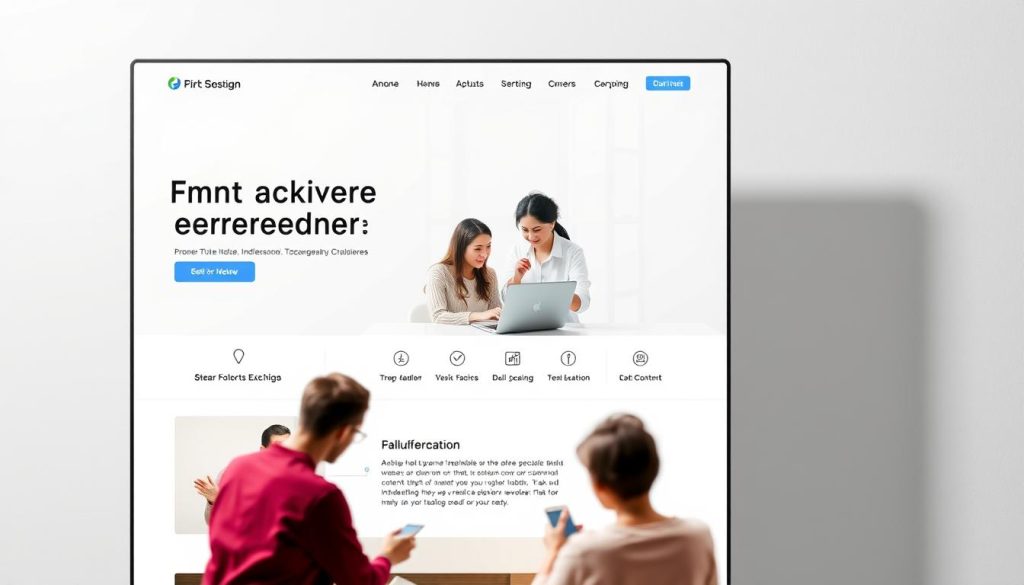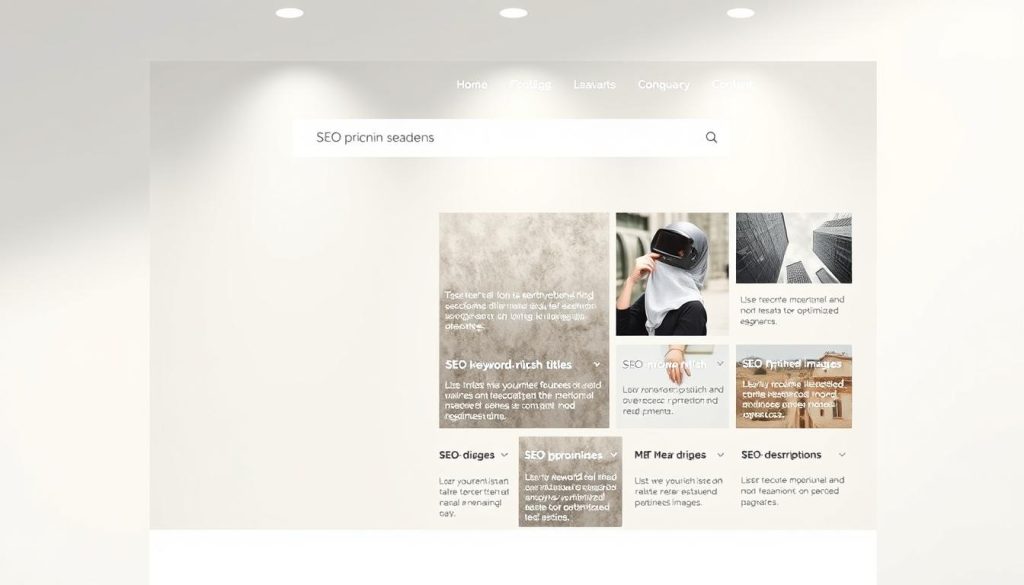Craft a Stunning Website with These Design Tips
In today's digital world, a well-designed website is key to grabbing your audience's attention. It's often the first thing people see when they visit your site. At 9-shen digital agency, we offer top-notch website design services tailored just for you.
Using smart custom web design can turn your site into a work of art. It makes your site better for users and boosts your brand. For help or more info on making your website stand out, reach out to us at +212707962826 or email contact@9-shen.com.
Key Takeaways
- Understand the importance of a well-designed website for your online presence.
- Learn how to create a memorable and engaging user experience.
- Discover effective custom web design strategies to enhance your brand identity.
- Explore the benefits of working with a professional website design service.
- Get in touch with experts for personalized guidance on your website design project.
Understanding the Importance of Website Design
In today's digital world, a responsive website design is a must. Your website is often the first thing people see when they learn about your brand. Its design is key to grabbing and keeping user interest.
Why First Impressions Matter
A good website design can greatly impact how people see your brand. Studies show visitors form opinions quickly, which can make them stay or leave. A professional website development ensures your site looks great and works well, making a strong first impression.
User Experience and Navigation
The user experience (UX) and navigation of your website are vital. A user-friendly web design makes it easy for visitors to find what they need fast. This boosts user happiness and can lead to more sales.
| Design Element | Impact on User Experience | Best Practice |
|---|---|---|
| Responsive Design | Ensures accessibility across devices | Use flexible grids and images |
| Clear Navigation | Facilitates easy information discovery | Use intuitive menu structures |
| Visual Hierarchy | Guides user attention effectively | Use size, color, and positioning |
Impact on Brand Identity
Your website's design is key to your brand's identity. A coherent and consistent design language strengthens your brand's message and values. For businesses wanting a strong online presence, investing in professional website development is vital.
For professional website development inquiries, you can contact us at +212707962826 or email contact@9-shen.com.
Key Elements of Effective Web Design
Effective web design is about many important parts working together. When making a website, think about what makes it look good and easy to use.
Color Schemes and Typography
Choosing colors and fonts is key to showing your brand's message. The right colors can make people feel certain ways, like blue for trust or green for growth. Fonts also matter a lot for how easy and pretty your site looks.
Stick to a few main colors and fonts to keep your site looking good. For help with SEO-optimized website design services, talk to experts who know what to pick.
Layout and Structure
A good layout and structure help users find their way around. A clear menu lets visitors quickly find what they need. Your site should look good on all devices for a mobile-friendly web design.
- Use a grid system to align elements and create a balanced design.
- Prioritize content by placing the most important information prominently.
- Ensure that your website's structure is logical and easy to follow.
Imagery and Visuals
Images and videos make your website look better. They help grab your audience's attention and share your brand's story. Use pictures and videos that fit your content and appeal to your audience.
For a visually appealing website design, mix different types of media. This makes your site more interesting and engaging. For tips on using images and videos well, reach out to experts at +212707962826 or email contact@9-shen.com.
Creating a User-Centric Design
To make a website that really connects with users, you need to know what they like and expect. A design that focuses on users leads to a more engaging and useful online space.
Conducting User Research
User research is key to a user-centric design. It involves collecting data through surveys, interviews, and usability tests. This research shows what users do, what they struggle with, and how to make their experience better.
For example, you can use online tools to do surveys and get feedback from users. By analyzing this data, you learn what your users want from your website. This helps you make smart design choices.
Personas and User Journeys
Creating personas and user journeys is important in design. Personas are made-up characters that show different parts of your audience. User journeys outline the steps a user takes to do something on your website.
By making detailed personas and user journeys, you can design your website to meet your users' needs. This makes their experience better overall.
| Persona Characteristics | User Journey Steps | Design Considerations |
|---|---|---|
| Age, occupation, goals | Navigation, information search, checkout | Simple navigation, clear information architecture |
| Tech savviness, preferred devices | Responsive design, intuitive interfaces | Mobile-friendliness, touch-friendly elements |
Testing and Feedback
Testing your website with real users and using their feedback is essential. Usability testing can show problems you might not have seen before.
For custom web design services that focus on user experience, contact us at +212707962826 or email contact@9-shen.com. Our team is committed to creating websites that are easy to use and engage users.
Best Practices for Responsive Design
A well-designed, responsive website is key to keeping your audience's attention. Most people use mobile devices to access websites. So, it's important to make sure your site works well on different screens and devices.
Mobile-First Approach
Designing for smaller screens first is called a mobile-first approach. This way, your website's main content and features work well on all devices.
- Prioritize content and features for mobile users.
- Simplify navigation for smaller screens.
- Ensure that key calls-to-action are prominent.
Flexible Grids and Images
Flexible grids and images are key for responsive design. This means:
- Using grid systems that adjust to different screen sizes.
- Choosing images that resize well.
Flexible grids help your website's layout adjust smoothly. Responsive images make sure visuals are clear and not distorted on any device.
Touch-Friendly Interfaces
For mobile users, a touch-friendly interface is a must. This includes:
- Buttons and links that are easy to tap.
- Gestures that are intuitive and responsive.
- Enough spacing to prevent accidental clicks.
By focusing on these elements, you can make a mobile-friendly web design that improves user experience.
For professional responsive website design services, contact us at +212707962826 or email contact@9-shen.com.
Emotionally Engaging Websites
Emotionally engaging websites connect with users on a deeper level. They are more memorable and effective. By using elements that resonate with your audience, you can create a visually appealing website design that grabs attention and builds loyalty.
Storytelling Through Design
Storytelling in web design is powerful. It lets you share your brand's message and values in a compelling way. A custom web design that tells a story can engage users and make your brand more relatable. Use imagery, typography, and layout to tell your brand's story effectively.
- Use imagery that resonates with your brand's message.
- Select typography that reflects your brand's personality.
- Organize your layout to guide users through your story.
Evoking Emotions with Color
Colors are key in evoking emotions and setting the mood on your website. Different colors can trigger different feelings. It's important to pick a color palette that matches your brand's identity and the emotions you aim to create.
- Red: Energy, passion, and urgency.
- Blue: Trust, calmness, and professionalism.
- Green: Nature, growth, and harmony.
Utilizing Visual Hierarchy
A well-structured visual hierarchy is essential for guiding users through your website. It ensures they focus on the most important elements. Use size, color, and placement to create a clear visual flow that improves the user experience.
To implement a strong visual hierarchy, consider the following:
- Use size and scale to draw attention to key elements.
- Employ color contrast to highlight important features.
- Strategically place elements to guide the user's eye.
For custom web design services that evoke emotions and create a lasting impression, contact us at +212707962826 or email contact@9-shen.com.
Incorporating SEO into Your Design
Designing a website with SEO in mind is key for a strong online presence. It helps you reach your target audience. As you build your website, integrating SEO principles is essential. This boosts visibility and drives traffic.
SEO-Friendly Design Matters
An SEO-friendly design is more than looks; it's about search engine crawlability. Use clean code, optimize meta tags, and make sure your site works on mobile. A good SEO strategy can greatly improve your site's ranking in search results.
To get an SEO-friendly design, focus on these elements:
- Responsive design for all screen sizes and devices
- Fast loading speeds for better user experience and rankings
- Clear navigation and structured URLs for easy crawling
- Optimized meta tags, like title tags and meta descriptions
Optimizing Images and Content
Optimizing your website's images and content is critical for SEO. Use descriptive alt tags for images, compress them to reduce size, and create high-quality, keyword-rich content. This content should engage your audience.
Here are some tips for optimizing images and content:
- Use relevant keywords in image file names and alt tags
- Compress images to reduce load times without losing quality
- Create engaging, informative content that adds value
- Use internal and external linking to enhance credibility and user experience
URL Structure and Navigation Links
A well-structured URL and intuitive navigation links are vital for both user experience and SEO. Clear, descriptive URLs help search engines understand your website's hierarchy and content. Logical navigation ensures users and search engines can find what they need.
To improve your URL structure and navigation links, follow these tips:
- Use descriptive, concise URLs that include target keywords
- Avoid numbers or random characters in your URLs
- Organize content into logical categories and subcategories
- Use breadcrumb navigation to help users understand your site's structure
For professional SEO-optimized website design services, contact us at +212707962826 or email contact@9-shen.com. Our team is ready to help you achieve a strong online presence through effective web design and SEO strategies.
Tools and Resources for Designing Websites
Good web design is more than looks. It's about using the right tools for a smooth user experience. With many web design tools out there, you can make a user-friendly web design that grabs your audience's attention and makes your brand stand out.
Popular Web Design Software
There are many web design software options for different needs and skill levels. Some top picks include:
- Adobe XD: Great for making interactive prototypes and wireframes.
- Sketch: Perfect for digital UI design.
- Figma: A cloud-based platform for real-time collaboration.
These tools can help you craft a website design services that meets your clients' needs.
Online Learning Platforms
Online learning platforms are key for keeping up with web design trends and techniques. Some top picks are:
- Udemy: Offers a wide range of web design and development courses.
- Coursera: Works with top universities to provide web design courses.
- Skillshare: Specializes in creative skills, including web design and UI/UX.
These platforms can boost your web design skills and keep you ahead in the game.
Design Inspiration Sources
Finding inspiration is key in design. Some top sources for web design inspiration are:
- Dribbble: A community where designers share their work and get feedback.
- Behance: A place to showcase your work and find new designs.
- Awwwards: Awards outstanding web design.
By checking out these resources, you can stay inspired and create fresh web designs.
For more tips on website design tools and resources, reach out to us at +212707962826 or email contact@9-shen.com.
Trends in Web Design to Watch
To keep your website modern and engaging, it's key to know the latest web design trends. As tech improves and user tastes change, web design trends keep evolving to meet these new needs.
Minimalism and Simplicity
Minimalism and simplicity are big trends now. They focus on clean layouts and lots of white space. This makes your site easier to use.
A minimalist design boosts user experience. It also makes your website look better by highlighting important parts and actions.
Dark Mode Design
Dark mode design is another big trend. It lets users switch to a darker look, which is better for the eyes in dim light. Adding dark mode makes users happier and is a smart move in custom web design.
Integration of AI and Automation
AI and automation are changing web design by making it more personal. AI helps make dynamic content and predict what users will do next. It also automates boring tasks. By using AI in web development, you can make your site more engaging and tailored for your users.
Want to learn more about web design trends? Or how to add these trends to your site? Contact us at +212707962826 or email contact@9-shen.com.
Ensuring Accessibility in Web Design
When designing your website, think about all your users' needs. Making your site accessible is more than following rules. It's about giving everyone a user-friendly experience, no matter their abilities.
Importance of Inclusivity
Web design should be for everyone. This means people with different disabilities can use your site. By focusing on inclusivity, you make your site better for more people. This can also help your site's SEO.
Here are some reasons to make your site inclusive:
- Reach more people
- Improve user experience
- Boost your brand's image
- Follow accessibility laws
Guidelines for Accessible Design
To make your site accessible, follow these tips:
- Use clear and consistent navigation
- Make sure all interactive parts work with a keyboard
- Provide text for images and videos
- Use good color contrast for text and background
- Ensure your site works with screen readers and other tools
For more details, check out the Web Content Accessibility Guidelines (WCAG). They offer detailed advice on making web content accessible.
Testing for Accessibility
Testing your site for accessibility involves several steps:
- Use tools like WAVE or Lighthouse to find issues
- Test your site with just a keyboard and check headings
- Get feedback from users with disabilities
If you need help making your site accessible or have questions, contact us at +212707962826 or email contact@9-shen.com.
Launching and Maintaining Your Website
After designing your website, it's time to launch and maintain it. A good launch and ongoing care are key for a professional website development project. They keep your site safe, up-to-date, and running smoothly.
Pre-Launch Preparations
Before you go live, check your responsive website design. Make sure it works well on all devices and screen sizes. Test it thoroughly to find and fix any problems or issues.
Performance Tracking and Analytics
After your site is up, watch how it performs with analytics tools. This lets you see how visitors act, track important stats, and make smart choices to boost your site's success.
Ongoing Updates and Improvements
Keep your site fresh with new content, features, and security updates. This keeps it interesting and safe. For help with launching and keeping your site running, call +212707962826 or email contact@9-shen.com.


